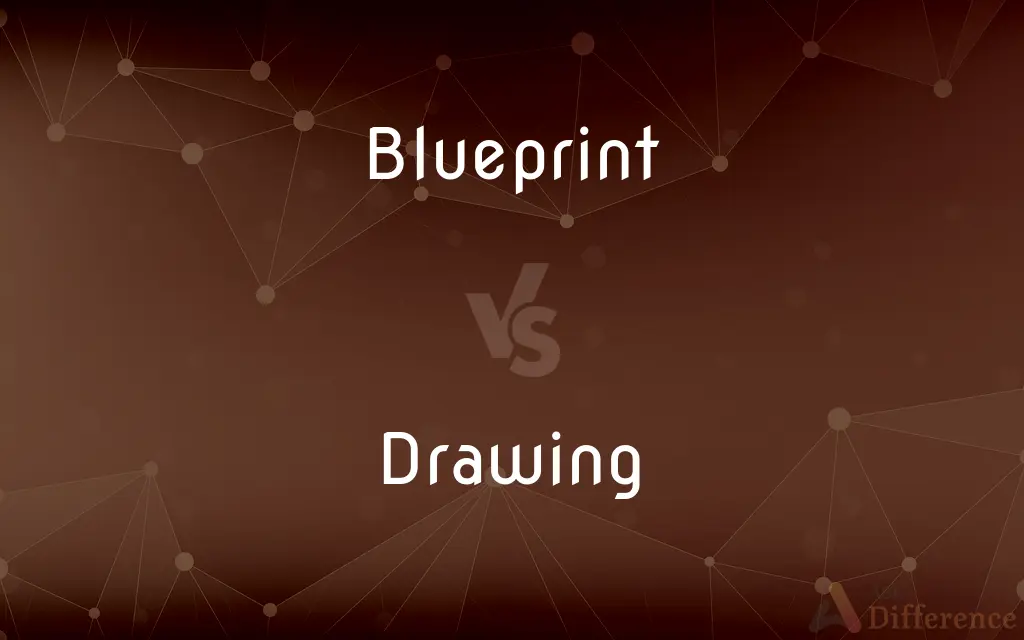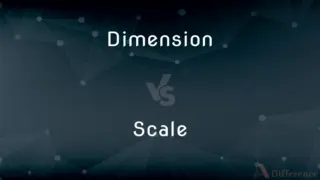Blueprint vs. Drawing — What's the Difference?
By Urooj Arif & Fiza Rafique — Updated on April 4, 2024
Blueprints are detailed technical plans used in architecture and engineering, showcasing construction details. Drawings, while also visual representations, can range from artistic sketches to detailed design plans, not limited to technical fields.

Difference Between Blueprint and Drawing
Table of Contents
ADVERTISEMENT
Key Differences
Blueprints are specific types of drawings, characterized by their technical nature and use in the design and construction of buildings, machinery, and other engineering projects. They are detailed plans that provide exact dimensions, materials, and procedures necessary for construction, typically created using specialized software or by hand in a precise, standardized manner. On the other hand, drawings encompass a broader category that includes any visual representation on a surface, such as paper, using tools like pencils, pens, or digital software. Drawings can be artistic, conceptual, or detailed designs but are not limited to the technical precision and specificity required in blueprints.
The term "blueprint" originally referred to a specific printing process used for creating technical drawings, which produced blue background and white lines. Today, while the traditional blue-colored prints are less common, the term still denotes detailed technical plans. Drawings, conversely, have a wider application, serving as the basis for artistic expression, conceptual design, or preliminary sketches in various fields, not necessarily requiring the detailed specifications found in blueprints.
Blueprints play a crucial role in the construction and manufacturing industries, serving as a guide for builders, contractors, and engineers to follow, ensuring that structures and components are built correctly. They include specific annotations, symbols, and scales to convey complex information. Drawings, while they can be precise and detailed, such as architectural sketches or product designs, might not include the level of detail about materials, dimensions, and processes that blueprints do. Instead, drawings might focus more on aesthetics, concept, or layout without delving into the specifics required for construction or manufacturing.
The creation process for blueprints involves a thorough understanding of engineering principles, building codes, and technical drawing standards, requiring training in architectural or engineering drafting. Drawing, depending on its purpose, might require a range of skills from artistic talent to technical drafting abilities, but the training and background needed can vary widely based on the drawing’s intent and level of detail.
While both blueprints and drawings serve to convey information visually, the intent behind each is what distinguishes them. Blueprints are intended as a definitive guide for constructing a physical object or structure, detailed enough to leave no ambiguity in interpretation. Drawings, however, can be exploratory, expressive, or functional without the need for the specificity and technical detail required in blueprints, offering a broader range of use and interpretation.
ADVERTISEMENT
Comparison Chart
Definition
A detailed technical plan for construction or engineering projects.
A visual representation created with pencils, pens, or digital tools.
Purpose
To guide the construction or manufacturing process with precise details.
Can range from artistic expression to conceptual design or detailed plans.
Technicality
Requires technical specifications, dimensions, and materials.
May or may not include technical details, depending on the type.
Fields of Use
Primarily used in architecture, engineering, and construction.
Used across various fields, including art, design, engineering, and architecture.
Skills Required
Knowledge of engineering principles, technical drawing standards, and building codes.
Skills can range from artistic ability to technical
Compare with Definitions
Blueprint
Foundation plan for civil engineering projects.
The construction team reviewed the bridge's blueprint before starting work.
Drawing
Technical drawing of a mechanical system.
The technician drew a detailed drawing of the air conditioning system for repair.
Blueprint
Layout for electrical systems.
The electrician followed the blueprint closely to install the complex wiring system.
Drawing
Diagram explaining a scientific concept.
The teacher used a drawing of the water cycle to explain evaporation and condensation to the students.
Blueprint
Technical plan for constructing a building.
The architect submitted the blueprints for the new library to the city for approval.
Drawing
Conceptual design of a product.
The team brainstormed the new gadget with several quick drawings.
Blueprint
Floor plan for interior design projects.
The designer used the blueprint to plan the location of furniture and fixtures.
Drawing
Artistic sketch of a landscape.
She captured the beauty of the sunset in her pencil drawing.
Blueprint
Detailed design of a machine part.
The engineer created a blueprint for the new engine component to increase efficiency.
Drawing
Architectural sketch of a building’s facade.
The architect presented a drawing of the proposed building’s exterior to the client.
Blueprint
A blueprint is a reproduction of a technical drawing or engineering drawing using a contact print process on light-sensitive sheets. Introduced by Sir John Herschel in 1842, the process allowed rapid and accurate production of an unlimited number of copies.
Drawing
Drawing is a form of visual art in which an artist uses instruments to mark paper or other two-dimensional surface. Drawing instruments include graphite pencils, pen and ink, various kinds of paints, inked brushes, colored pencils, crayons, charcoal, chalk, pastels, erasers, markers, styluses, and metals (such as silverpoint).
Blueprint
A contact print of a drawing or other image rendered as white lines on a blue background, especially such a print of an architectural plan or technical drawing. Also called cyanotype.
Drawing
The act or an instance of drawing.
Blueprint
A mechanical drawing produced by any of various similar photographic processes, such as one that creates blue or black lines on a white background.
Drawing
The art of representing objects or forms on a surface chiefly by means of lines.
Blueprint
A detailed plan of action.
Drawing
A work produced by this art.
Blueprint
A model or prototype.
Drawing
Present participle of draw
Blueprint
To make a blueprint of.
Drawing
A picture, likeness, diagram or representation, usually drawn on paper.
Blueprint
To lay a plan for.
Drawing
The act of producing such a picture.
Blueprint
A type of paper-based reproduction process producing white-on-blue images, used primarily for technical and architecture's drawings, now largely replaced by other technologies.
Drawing
Such acts practiced as a graphic art form.
Blueprint
A print produced with this process.
Drawing
The process of drawing or pulling something.
Proverb: An official is great in his office as a well is rich in drawings of water.
Blueprint
A detailed technical drawing (now often in some electronically storable and transmissible form).
Drawing
An act or event in which the outcome (e.g., designating a winner) is selected by chance in the form of a blind draw, notably of lots; especially such a contest in which a winning name or number is selected randomly by removing (or drawing) it from a container, popularly a hat.
Blueprint
Any detailed plan, whether literal or figurative.
Drawing
A small portion of tea for steeping.
Blueprint
To make a blueprint for.
The architect blueprinted the renovation plan once the client had signed off.
Drawing
The act of pulling, or attracting.
Blueprint
To make a detailed operational plan for.
They blueprinted every aspect of the first phase of the operation.
Drawing
The act or the art of representing any object by means of lines and shades; especially, such a representation when in one color, or in tints used not to represent the colors of natural objects, but for effect only, and produced with hard material such as pencil, chalk, etc.; delineation; also, the figure or representation drawn.
Blueprint
See under Print.
Drawing
The process of stretching or spreading metals as by hammering, or, as in forming wire from rods or tubes and cups from sheet metal, by pulling them through dies.
Blueprint
Something intended as a guide for making something else;
A blueprint for a house
A pattern for a skirt
Drawing
The process of pulling out and elongating the sliver from the carding machine, by revolving rollers, to prepare it for spinning.
Blueprint
Photographic print of plans or technical drawings etc.
Drawing
The distribution of prizes and blanks in a lottery.
Blueprint
Make a blueprint of
Drawing
An illustration that is drawn by hand and published in a book or magazine;
It is shown by the drawing in Fig. 7
Drawing
A representation of forms or objects on a surface by means of lines;
Drawings of abstract forms
He did complicated pen-and-ink drawings like medieval miniatures
Drawing
The creation of artistic drawings;
He learned drawing from his father
Drawing
Players buy (or are given) chances and prizes are distributed according to the drawing of lots
Drawing
Act of getting or draining something such as electricity or a liquid from a source;
The drawing of water from the well
Drawing
The act of moving a load by drawing or pulling
Common Curiosities
Can anyone learn to draw blueprints?
While anyone can learn the basics of drafting, creating accurate blueprints for construction or engineering projects requires specialized training in architectural or engineering drafting.
How do copyright laws apply to blueprints and drawings?
Copyright laws protect both blueprints and drawings as original works of authorship, provided they are fixed in a tangible medium of expression. This means that the creator has exclusive rights to reproduce, distribute, and display the work, with specific regulations and exceptions depending on the jurisdiction.
Are blueprints still blue?
While the traditional blueprinting process resulted in blue backgrounds with white lines, modern blueprints are more likely to be black and white. The term "blueprint" remains as a legacy of the original process.
Is specialized software required to create blueprints?
Yes, creating modern blueprints typically requires specialized CAD (Computer-Aided Design) software to ensure precision and adherence to standards.
Can a drawing become a blueprint?
Yes, an initial drawing or sketch can be developed into a detailed blueprint if it is refined with technical specifications and standards required for construction or manufacturing.
Are digital tools replacing traditional methods for creating blueprints and drawings?
Digital tools have become predominant in creating both blueprints and drawings due to their efficiency, precision, and versatility, though traditional methods are still valued for certain applications and artistic expressions.
What’s the main reason to choose a drawing over a blueprint for a project?
Drawings are chosen for conceptualizing, artistic expression, or preliminary design, while blueprints are necessary for detailed planning and construction.
Can blueprints and drawings be considered art?
While blueprints are generally viewed as technical documents, both blueprints and drawings can be appreciated as art, especially when they exhibit aesthetic qualities or are displayed with an emphasis on their artistic value. Architectural blueprints, for example, can be admired for their precision and beauty and may be displayed in art galleries or architectural exhibitions.
Do architects create drawings or blueprints?
Architects create both; they might start with drawings to conceptualize designs and then produce detailed blueprints for construction.
How important is precision in a drawing compared to a blueprint?
Precision is critical in blueprints due to their technical nature and the need for accurate construction, while the level of precision in drawings can vary based on their purpose.
Share Your Discovery

Previous Comparison
Dimension vs. Scale
Next Comparison
Panzerotti vs. CalzoneAuthor Spotlight
Written by
Urooj ArifUrooj is a skilled content writer at Ask Difference, known for her exceptional ability to simplify complex topics into engaging and informative content. With a passion for research and a flair for clear, concise writing, she consistently delivers articles that resonate with our diverse audience.
Co-written by
Fiza RafiqueFiza Rafique is a skilled content writer at AskDifference.com, where she meticulously refines and enhances written pieces. Drawing from her vast editorial expertise, Fiza ensures clarity, accuracy, and precision in every article. Passionate about language, she continually seeks to elevate the quality of content for readers worldwide.














































